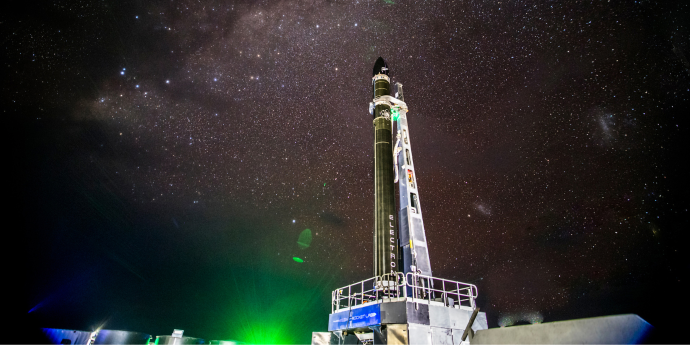Bringing startup expertise to the boardroom
Supporter of innovative businesses, Maria King MInstD was thrilled to see startup governance in the IoD Advanced Directors' Course.
Rocket Lab put New Zealand’s aerospace industry on the map, but a pioneer fears we are failing to capitalise on its success.

From cutting-edge America’s Cup yacht design to a slew of Hollywood-scale productions filmed here, New Zealand has a handful of industries that emerged from left field to achieve global success.
The latest is our aerospace sector, dominated by Rocket Lab, which has been sending satellites into orbit from its Māhia Peninsula site since 2017. Rocket Lab listed on the Nasdaq last August, and while its shares have slumped along with most tech stocks, the Peter Beck-helmed company still has a market capitalisation of US$2.4 billion and is widely seen as a “mini SpaceX”.
What’s the formula? How do we occasionally hit it out of the park well beyond our wheelhouse of primary sector products?

Mark Rocket
“I’m really not sure,” laughs Mark Rocket MInstD, the founder of solar-powered autonomous plane maker Kea Aerospace and the co-founder and seed investor in Rocket Lab in 2007.
“Here in Canterbury, we did have Richard Pearse and Wigram certainly has a strong aviation history,” says Rocket. “I think many of us would love to see aerospace being embedded in the Kiwi psyche, and in the same way we see ourselves now as filmmakers and boatmakers, and winemakers,” Rocket says.
Our success in highly valuable niches isn’t usually down to savvy planning and foresight on the part of government bureaucrats. More often, a driven entrepreneur – Sir Peter Jackson, for example – is able to build a talented team and attract just enough funding to get an ambitious project off the ground. Our innate ability to innovate on the smell of an oily rag helps.
Such was the case with Beck and Rocket Lab. The whole premise of the company was to radically lower the cost and increase the frequency of satellite launches by using a small, reliable and reusable rocket.
While Rocket Lab is now technically a US company, with major operations in California, it still has a large R&D and engineering team in Auckland and a mission control centre that monitors its launches.
“It’s an incredible outcome,” says Rocket, who departed Rocket Lab in 2011 and now leads another promising start-up in Kea Aerospace. Instead of going to space, Kea has its eye on the stratosphere, where it plans to position lightweight planes that can stay aloft for months at a time to take high-resolution images of Earth.
Why not just send a camera into space on Beck’s Electron rocket? “Unless you’ve got a Hubble-size lens pointing down at Earth, then you’re not going to get the high-resolution imagery you need,” Rocket explains.
Manned flights are currently deployed to take more detailed imagery, but it is expensive to hire pilots, buy aviation fuel and wait around for a fine day conducive to taking crystal-clear photos. As such, most detailed aerial photography is only updated every three to four years.
“It needs to be an extremely light airframe that’s robust enough to handle the extreme conditions of the stratosphere . . .”
“That’s not frequent enough if you want to monitor rapid changes on the land and in waterways,” Rocket says.
Kea last year flew its prototype X10 aircraft for 36 hours nonstop, ending the flight only due to fog rolling in. Aerial balloons have been testing the communications equipment for the craft, which Rocket hopes to start testing with short-run flights in February. The aim is to start perpetual flight trials in the stratosphere carrying a 10kg payload a year later. The engineering challenges involved are massive.
“It needs to be an extremely light airframe that’s robust enough to handle the extreme conditions of the stratosphere, where you get to -65 degrees [Celsius],” he says.
But the advantage is that there is very little in the stratosphere to get in the way of Kea’s planes, other than the occasional rocket launch or weather balloon. Kea is one of a growing group of start-ups working in an area Rocket considers to be our real sweet aerospace spot – advanced aviation.
They include Electric Air, SkyBase, Argo Navis, Pyper Vision, Merlin Labs and Kea, companies focused on autonomous aircraft, drones and the various technologies that go into them. US company Wisk Aero has also been trialling its all-electric, self-flying air taxi vehicles in the Canterbury basin.
New Zealand is a hotbed of development in niches that will shape the future of aviation. But Rocket fears our regulatory regime is holding us back. He points to Wisk’s decision in June to set up operations in Queensland, which he puts down to greater regulatory flexibility enabling Wisk to expand its trials.
“All around the world, there’s been a big problem with beyond visual line-of-sight flight for non-military aircraft,” says Rocket.
While the Civil Aviation Authority accommodated Wisk’s flight tests in New Zealand under its Airspace Integration Trial Programme, and the government introduced legislation to clear the way for Rocket Lab’s launches, our once accommodating regulatory regime hasn’t kept pace with the industry’s needs.
“We’re kind of stuck between this paradigm of the 1950s, navigating by looking out the aeroplane window, and moving into this Blade Runner future where we’re going to have sky lanes and everything is digital,” Rocket says.
New Zealand could be a test bed for commercial uses of long-distance autonomous aircraft, but other countries have their eye on aerospace, too. Australia, in particular, is ramping up its investment. A facility has been built in Adelaide for aerospace manufacturing and Australia has returned to its own roots launching rockets into space, which stretch back to the 1950s.
A series of suborbital rocket launches for NASA from the Arnhem spaceport in the remote Northern Territory this year was greeted as a “new era” in Australia’s space sector by Prime Minister Anthony Albanese.
“In New Zealand, I think we’ve over-promised and under-delivered,” Rocket says.
At the inaugural New Zealand Aerospace Summit in Christchurch in September, Rocket and other industry leaders made clear what needs to change. “We need to make sure the resourcing is appropriate for the Civil Aviation Authority and that there’s a willingness there to enable innovation,” he says. “Otherwise, we are going to miss the bus.”
He estimates that New Zealand has a window of one-to-two years to improve its regulatory regime to compete with other countries. The Ministry of Business, Innovation and Employment used the Christchurch gathering to launch a consultation on the Aotearoa New Zealand Aerospace Strategy and a review of the country’s space policy, so the industry has had a prime opportunity to push for urgent change.
“We’re kind of stuck between this paradigm of the 1950s, navigating by looking out the aeroplane window, and moving into this Blade Runner future where we’re going to have sky lanes and everything is digital.”
There are some positive developments already in progress. The government has a Māori-Crown partnership, Project Tāwhaki, in place to build aerospace R&D facilities on the Kaitōrete Spit, a 25km stretch of land on the Canterbury coast that was originally considered as a launch site for Rocket Lab.
Rocket says it could become an “aerospace sandpit” for test flights, R&D and autonomous vehicle training. “That’s a really exciting project and potentially could create thousands of jobs,” he says.
New Zealand’s value proposition in aerospace will never be about having the most money to spend or the grandest launch facilities.
“Our technology isn’t dominated by large military industrial complex agencies as per most developed countries,” Rocket says. “This gives us an opportunity to explore technology in different ways that can be aligned with our nuclear-free and humanitarian values, to focus technology development in areas such as sustainability.”
He would love to see “10 Rocket Lab-type companies” operating here. That requires the ‘Moon shot’-type strategic vision from our leaders that spurred NASA to put men on the Moon in the space of a decade in the 1960s.
Says Rocket: “We haven’t had our JFK moment yet.”